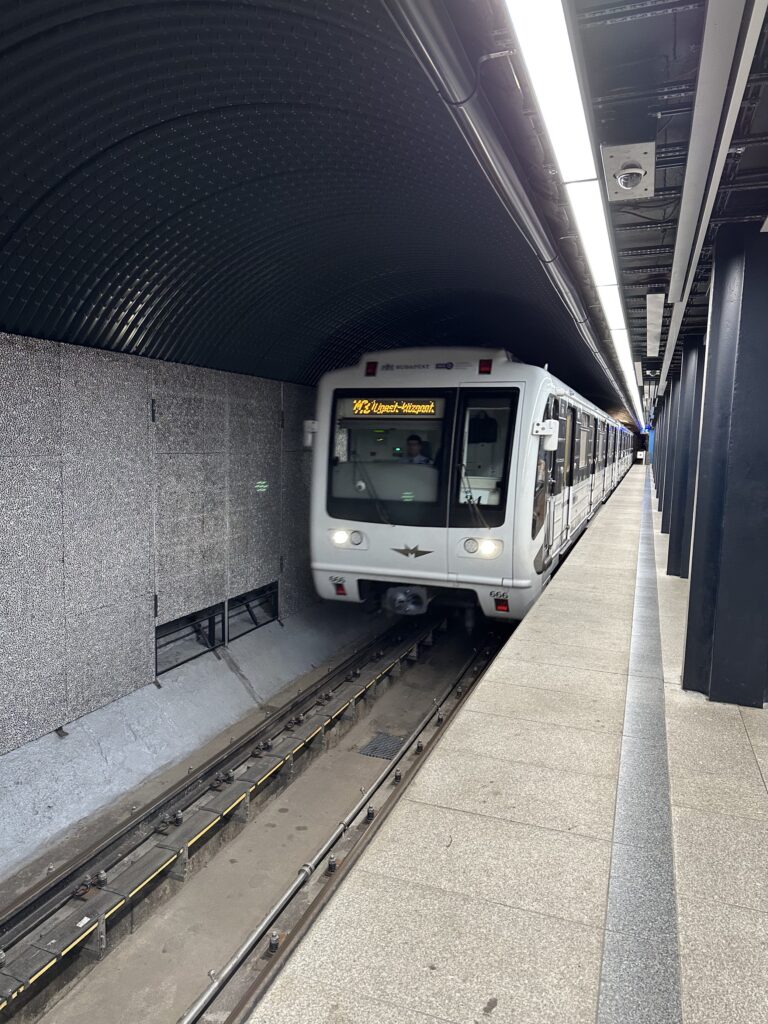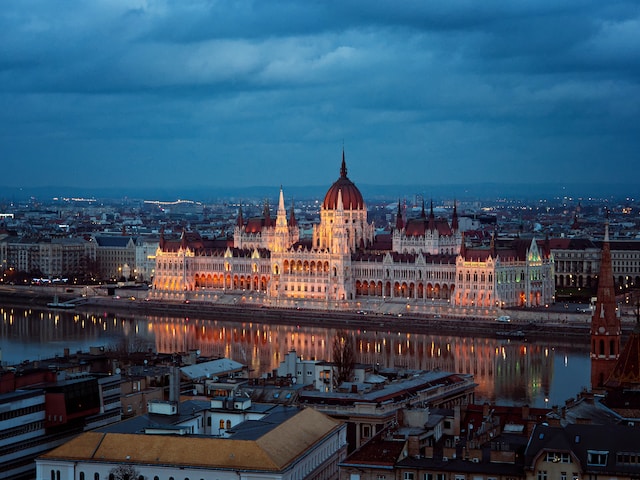Budapest has an extensive, effective, and cost-effective public transportation system. The city includes four metro lines, a vast network of buses, trolleybuses, and trams. Tickets are available at most kiosks and some newsstands, and the Budapest Transport Company (BKV) manages the transportation network. Tickets can also be bought directly from drivers or through mobile apps. Ticket types and usage periods affect price, however, prices are typically extremely reasonable. The city also features a network of bike lanes and bike-sharing programs, making it simple to travel around without taking public transportation.
Metro system in Budapest: basic information
Budapest’s metro system is a fantastic way to navigate the city. There are four lines that cover most of the city and link to other transportation options including buses and trams. The M1, M2, M3, and M4 lines all include stops at Budapest’s most significant landmarks. The metro system is cost-effective, dependable, and safe. Depending on your needs, you can buy single tickets or tickets valid for the entire day. Budapest’s metro system is a great option for getting around the city swiftly and comfortably.
The lines of the Budapest subway system
M1 – Yellow line
Line 1 or Metro 1 or M1 or Yellow Line, was constructed between 1894 and 1896. Locally, it is referred to as “the small underground”. The Mersey Railway in Liverpool is the third-oldest subway system in the world and the first on the European mainland, behind the London Underground. From the city’s heart on the Pest side, Line 1 travels northeast under Andrássy Bridge to the Városliget or City Park. It does not serve Buda, like Line 3. The estimated daily ridership is 80,000.
M2 – Red line
The second line of the Budapest Metro goes from Déli pályaudvar in north-central Buda, the line travels east under the Danube to the city center, where it then continues east along the path of Rákóczi tér until its terminus at örs vezér tere. It was the sole line that served Buda until Line 4 opened in 2014. The estimated daily ridership is 350,000.
M3 – Blue line
The third and longest line of the Budapest Metro is sometimes known as the North-South Line. It follows the general route of Váci’t south from Pest to the city center and then follows Ülli’t south-east to Kbánya-Kispest, running almost parallel to the Danube on the Pest side. The estimated daily ridership is 500,000. It does not service Buda, like Line 1.

M4 – Green line
The first section, which is 7.4 km long and has ten stations, crosses the Danube to link the Buda and Pest cities of Buda’s Kelenföld vastállomás and Keleti pályaudvar in the east. Three more sections, one going east to Bosnyák tér, one going west to Virágpiac, and one going farther east to jpalota, have been planned but have not yet received funding from the European Union or the city of Budapest. Only Line 2 served the Buda side of the river before Line 4 was constructed. The estimated daily ridership is between 185,000 and 195,000. Despite the fact that the fundamental city layout and population density were unaltered, the construction of the line in Hungary received harsh criticism for its route. The line is known for its exorbitant price and frequent construction delays (17 in all).
Map of Budapest Metro 2023 – Free Download in PDF

Click and download the map of Budapest’s underground system for 2023
You can download the Budapest Metro Map 2023 for free in PDF format. Anyone visiting or residing in Budapest can greatly benefit from this map. It includes all of the metro lines that are currently in operation as well as any future lines that might be added. The map also has a legend with information on stations, distances, and other things. It has never been simpler to navigate Budapest than it is now, thanks to this map. Get started exploring the city for free and conveniently by downloading the Map of Budapest Metro 2023.
Public transport tickets in Budapest: the Best types for travelers and actual prices
Budapest may be easily and cheaply explored by traveling around the city. You can choose the ideal ticket with a selection of price ranges and ticket options.
The single-journey ticket is the most commonly used form of transportation in Budapest. They are available on all forms of transportation, including buses, trams, trolleybuses, suburban railways, and metro lines, and cost 350 HUF each (around 1.15 EUR). Single-journey tickets must be validated in the ticket machine or through a QR code before use and are only good for one trip.
Consider getting a 24-hour travel pass if you intend to use public transportation frequently. The 24-hour pass costs 1650 HUF (around 5.30 EUR) and entitles the bearer to unlimited travel on all forms of public transportation for 24 hours starting at the time of validation.
A seven-day pass is also offered for those who plan to stay a while. This pass costs 4500 HUF (around 14.50 EUR) and entitles the holder to unlimited use of any public transportation for seven days starting at the time of validation.
The 24-hour pass is the most economical choice for visitors who will be in Budapest for three days. For a full 24 hours, all public transportation is free to use, giving you plenty of time to tour the city.
Timetables & Schedules of the Budapest Metro system
Every day from 4:30 a.m. to 11:30 pm, the Budapest Metro is open. From Monday through Friday, trains arrive every two to three minutes during peak hours. The frequency of trains drops to every five to seven minutes on Saturdays and Sundays. The metro system is open from 5 a.m. to 10:30 p.m. on major holidays. Between 11:30 pm and 4:30 am, night buses also travel along the same lines as the metro. The best way to find out more information is to check the website or contact a station worker because some lines may have varied operating hours.
What Are Other Options For Public Transportation In Budapest?
In addition to the metro, Budapest offers a wide variety of other public transit choices. These include buses, ferries, trams, and trolleys. Trams are helpful for getting about the city because they follow a set path and stop frequently. When traveling between the city center and the outskirts, trolleys provide a more picturesque path.
how does the public bus transportation work in Budapest
The Budapest Transport Center (BKK) is in charge of managing the city’s public bus system. This company runs a fleet of buses that travel the city on a regular basis. These buses are easily identified because they are marked with a red B sign.
Number 16 bus travels from the city center to the Gellért Hill neighborhood and the 104 bus travels from the city center to the Castle Hill region. From the city’s heart, take the 5 bus to the Great Market Hall. From the city’s center to the Parliament building, take bus route number 7. From the city’s core to the Széll Kálmán tér metro station, use bus number 8. All of these lines are conveniently located and provide a fantastic opportunity to see the city.
The 100E bus travels from the city’s core to the airport for people who like to go further afield. For travelers trying to catch an early flight, this route is very practical. From the city center to Szentendre, take the 200E bus. For day trips outside of the city, many people choose to take this line.
Trams in Budapest – Lines and Map
The tram system in Budapest is part of the mass transit system of the capital city of Hungary. The tram lines serve as the second most important backbone of the transit system (after the bus network), carrying almost 100 million more passengers annually than the Budapest Metro. Budapest has over 40 tram lines that run throughout the historic center.
The most useful tram lines for tourists are:
- Tram line 2: This line runs along Pest’s Riverbank, providing great views over the Danube and Buda Hills. The route passes by landmarks such as the Chain Bridge, the Hungarian Parliament, and the Central Market Hall on the eastern bank. The tram runs from Közvágóhíd to Jászai Mari Square, which is the closest stop to Margaret Island.
- Tram lines 19 and 41V: These lines travel along Buda’s riverside, very similar to the tram no. 2 route, but on the western part of the city. It links Batthyány tér (St. Anne’s Church) with Gellért Hill. If you get off at Gellért Hill, you can visit Gellert Spa, one of the most famous thermal baths in Budapest and then see the Citadella. Both retro trams connect with Batthyány Square, a station on the metro line 2 (red line).
Trams in Budapest run from 4:30 am to 11 pm. The most important lines run every 5 to 10 minutes. All of Budapest’s means of transport use the same tickets and travel passes and cost the same price
International TRAINS from Budapest – Train stations and routes
Budapest has three main railway stations: Keleti (East) Station, Deli (South) Station, and Nyugati (West) Station. All three stations have tourist information offices and are connected by the metro to Deak ter in the inner city (Belvaros).
Budapest Keleti is the main international and inter-city railway terminal in Budapest, Hungary. The station stands where Rákóczi Avenue splits to become Kerepesi Avenue and Thököly Avenue. Its name in 1891 originates not only from its position as the easternmost of the city’s rail termini, but from its original role as a terminus of the lines from eastern Hungary including Transylvania, and the Balkans.
The building was designed in an eclectic style by Gyula Rochlitz and János Feketeházy and constructed between 1881 and 1884. The main façade is adorned with two statues depicting James Watt and George Stephenson. Inside the station are frescos by Karoly Lotz.
As for international trains from Budapest, you can travel to other European cities from Budapest by train. The Hungarian national railways MÁV offers START Europa tickets, which provide the best prices for 15 countries. You can buy tickets from nearly every Hungarian station to nearly every one of the destination countries—or return. Some popular destinations include Vienna, Munich, Zurich, Prague, London, Paris, Berlin, Amsterdam, Frankfurt am Main, Brussels, Cologne, Stuttgart, and Mannheim.
How To Get From Budapest Ferenc Liszt International Airport (BUD) To The City Center With Public Transport?
The primary hub for international air travel to Hungary is Budapest Ferenc Liszt International Airport. Travelers entering the country will find it simple to reach the airport because of its proximity to the city core. Fortunately, there are numerous public transit options that make it simple to go from the airport to the city’s center.
Taking the Airport Minibus is the fastest and most practical way to go from Budapest Ferenc Liszt International Airport to the city center. Every 30 minutes, a minibus transports passengers from the airport to the city center; the trip takes around 30 minutes. The ticket booth in the airport arrivals area is where you may buy tickets for the Airport Minibus.
As an alternative, visitors can go from the airport to the city center on the bus 100E or 200E. Every 15 minutes, a bus line travels from the airport to the city center; the trip takes around 45 minutes. The ticket booth in the airport’s arrivals section is where you may buy bus tickets.
Finally, passengers may ride the railway into the heart of the city from the airport. Every 15 minutes, the Budapest Airport Train makes a trip from the airport to the city center, which takes around 35 minutes. At the ticket window at the airport’s arrivals section, you can buy train tickets.
Public transportation makes it simple and convenient to travel from Budapest Ferenc Liszt International Airport to the heart of the city. You can quickly go to the city center by taking the Airport Minibus, bus route 100E or 200E, or the Budapest Airport Train.
how to spend 3 days in Budapest?
Budapest is a stunning city with a wealth of things to see and do, making it challenging to see everything in a brief visit. We have thus developed a 3-day itinerary for Budapest that will provide you with a special and unforgettable experience. This itinerary will guarantee that you make the most of your stay in Budapest by putting an emphasis on neighborhood eateries, vibrant nightlife, and some of the city’s top attractions.
Take a walking tour on your first day to familiarize yourself with the area. The tour will pass by some of Budapest’s most recognizable sites, including the Fisherman’s Bastion and the Chain Bridge, and will provide you with information on the history and culture of the city. Why not have dinner at a neighborhood eatery after the tour? The Konyha restaurant, which offers conventionally prepared Hungarian fare with a contemporary twist, is recommended.
Explore some of the city’s most stunning attractions on day two. Admire the ornate architecture of the Buda Castle before taking a boat journey along the Danube to see the city from a different angle. Visit the Kleves restaurant for lunch to enjoy authentic Hungarian soups and stews. Experience the lively nightlife of the city in the evening. Budapest offers a wide variety of bars and clubs, but our favorite is the Instant club, which has a terrific ambiance and plays a wide variety of music.
Take a day trip to Lake Balaton on the last day of your vacation. You may unwind by the lake, go boating, or explore some of the local communities here. Visit the Kali Art Inn for lunch, where a variety of delectable regional specialties are served. Return to Budapest in the evening to take in all of the bars and pubs the city has to offer. Take a night cruise along the Danube to round off your trip in style and catch the city’s cityscape as the sun sets.
You may be certain that your three-day itinerary will provide you a special and unforgettable experience in Budapest. You’ll have plenty of memories to bring back from your exploration of the city’s sights, local cuisine, and nightlife. So why not begin making travel arrangements to Budapest today?
What other metro systems are nearby to Budapest?
Budapest, a significant metropolis in Eastern Europe, has a robust metro system. There are other local metro systems that service the surrounding areas in addition to the Budapest metro system. These include the metro systems of Austria’s Vienna, the Czech Republic’s Prague, and Poland’s Warsaw. With easy access to adjacent cities and attractions provided by each of these metro systems, both visitors and locals may explore the area more easily.
Summary of our tour guide for Budapest
Budapest has a fantastic public transit system, which I have grown to appreciate over the past five years of living here. Budapest’s public transit system is effective, practical, and reasonably priced. The bus network is enormous and reaches practically every part of the city, while the metro system is quick and dependable. Whether you’re going to work, out to dinner, or just enjoying the city, it’s simple to get around. Budapest’s public transit network, in my opinion, is dependable and reasonably priced, making it the best option for getting around the city.
Top 5 FAQs and answers about Budapest public transport?
What Budapest public transportation choices are there?
- Buses, trams, trolleys, and metro lines are all part of the large public transit system of Budapest. Additionally, there are suburban railways that link the city and its suburbs.
How can I navigate the city the most effectively?
- The fastest way to move around Budapest is via subway. The four metro lines are relatively speedy and cover the majority of the city. The city is also well-served by buses and trams, albeit they can move more slowly than the metro.
Are there any passes that are available at a discount?
- Yes. Tourists and locals can choose from a range of cheap passes in Budapest. These include the Budapest Card, which entitles you to discounts on museums and attractions in addition to access to public transit.
Is it simple to purchase tickets?
- Yes. Most metro stations have ticket vending machines, while bus and tram stops also have ticket offices where tickets can be purchased. Additionally, you can purchase tickets using the BKK smartphone app.
Are there any specific rules that need to be followed?
- Yes. Before entering a bus or tram, all passengers are required to authenticate their tickets. The ticket must be inserted into a machine on the bus or tram to accomplish this. A fine may be assessed for failing to validate tickets.
Useful links








